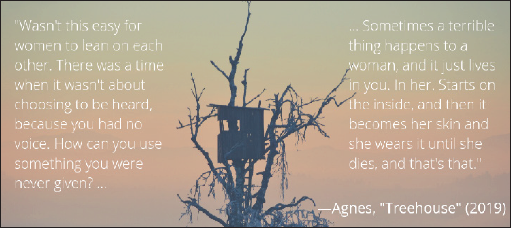If a new subgenre of cinema is going to be made, especially in response to societal trends, then “Treehouse” would’ve been the one to lead the charge. Unfortunately, it falls short of what it sets out to be.
“Treehouse” was released on March 1 as a Hulu Original, which means you have to have a subscription to Hulu to watch. It’s part of the “Into the Dark” horror anthology series, composed of various movies created and produced by Blumhouse Productions, the big horror movie factory of the last two decades. They produced hits like “Paranormal Activity,” “Insidious,” “Split” and “Halloween” (2018).
Peter Rake, the main character, has a strong establishing character scene in the first seven minutes of the movie, personified as a Gordon Ramsay-like celebrity chef known for his scathing remarks to amateur cooks he encounters on his show. The difference between Ramsay and Rake is that Rake can carry the hostility off the camera. Immediately following that short cooking scene, he interacts with his daughter Riley, who wants Rake to be at his ex-wife’s wedding for company.
While Rake is pretty tender with his daughter, he demonstrates his next defining character trait: lying. Rake lies to Riley about some business he needs to attend to this weekend, and Riley accepts this with disappointment. After she leaves the scene, he gets a phone call telling someone that he’s “ready to skip town for the weekend.”
He’s a fast speaker with a propensity to make somewhat inappropriate jokes but also charm you in the same breath. However, only the young and gullible would take his words as genuine, as shown through his interactions with Riley and a man named Lonnie, who Peter attended high school with. At one point during the movie, Lonnie comments that it was just him and his mother living in their fishing shop, to which Rake responds “yeah, just add a few rooms, poke a few holes and call it Bates Motel, eh? I’m sorry, I’m sorry.”
Anyway, Rake uses the weekend to catch up with his sister Gwen at their family home. Gwen, however, had to depart for some business at her job, leaving Peter with Agnes.
Agnes is the longtime maid to the Rake family, and is, in my opinion, the best character. Her snarky, honest and no-holds-barred attitude lightens the narrative and gives you a hearty laugh. She’s a joy in-scene, even though she doesn’t want to be there.
Things take a turn when a group of women on a bachelorette retreat get stranded without light. Rake offers them to stay in his old home and cook for them. Alcohol and libations are shared, and Rake has a little too much. Rake imparts some unsavory, misogynistic things to the women before passing out.
When he awakens, there is a steel collar around his neck and a crossbow aimed at his crotch. Yikes. Oh yeah, and the women are witches. Double yikes. This little coven decides to target Rake for past transgressions, revealed steadily throughout the movie.
Rake does not back down, despite the clear danger he’s in. He keeps his snarky attitude and verbally attacks the women a lot. There are some jolts, whimpers and even resignation at one point, but not complete defeat. In many horror movies, characters don’t often fight back against their assailants and completely resign themselves to fate. Rake’s opposition to this trope makes the movie more engaging and entertaining. He even beats some of the women at their own mental games and outsmarts them.
There seems to be a resurgence of witches laterly in horror media (e.g. “VVitch,” “Blair Witch”). But it can either be done really well or really poorly. “Treehouse” falls in between. While the use of witches is an interesting allegory for current wave of feminism, especially in light of the #MeToo movement, I feel like it doesn’t tackle the themes hard enough. It’s more of a surface-level vengeance story with the backdrop of feminism and #MeToo. It doesn’t quite live up to the potential it posed for social commentary.
This is minor, but I wonder why they couldn’t tweak the appearance of Elena or Morgan. They’re both brunettes with layered bangs and wavy hair down to their chin or neck area. It’s easy to get them mixed up in scenes when they’re not talking. Elena is of Hispanic heritage and has an accent, and Morgan is British, but that’s not enough to separate them visually.
I also wonder about the name of the movie, to be honest. The actual treehouse does play a plot-related role in the story, but does not go beyond that. This again addresses the issue of the movie — it has a great opportunity to use iconography and social commentary for meaningful storytelling but doesn’t take advantage of the opportunities it poses. What does the treehouse mean to Rake besides a memory that he barely regrets? What does it mean to Gwen? Is it a stretched metaphor for family bonds? I don’t know, I’m trying here.
Cinematography is a a huge plus in this movie. It is simple and controlled, and if you’re careful watching, can reveal a lot more about the story. You can also get some insight and even foreshadowing into Rake’s relationship dynamics by the camera angles and shot composition. When we first meet Riley, she is standing up on the counter of Rake’s restaurant, and he lets her down like a princess. It shows that Riley is one of the highest priorities in Rake’s life and then only thing that comes before his ego. His brief talk with Gwen reveals a lot about their relationship with isolated shots of both characters when they are talking about their deceased father; it shows that while they are cordial, they can easily devolve into opposing sides of a matter or incident.
Simpson’s Peter Rake character and cinematography are the best assets of “Treehouse.” While it has a culturally-relevant premise and revisits classic horror tropes, the movie does not deliver on its promise and muddles its narrative with an aggressive revenge plot and introduces commentary on other social issues. So, would I recommend it? If you like good cinematography and a strong Jimmi Simpson performance, go for it.




